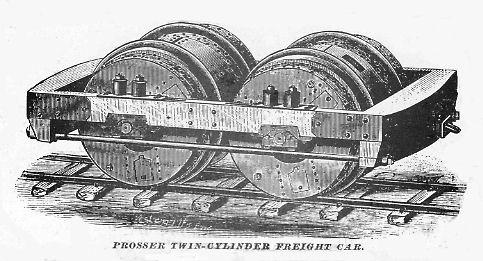“WHENEVER a mechanical novelty in railroading is broached, something
that seems to be a wide departure from ordinary practice, it is the
custom to set forth in glowing colors what the inventor claims for it,
and what it is theoretically intended to accomplish. Certain premises
are assumed in its favor, and these are not unfrequently [sic] made the
basis of detailed estimates in figures, showing such an immense saving
in the economy of cost and operation as to be quite revolutionary as
regards existing methods.“The Prosser Twin Cylinder Car, an engraving
of which we herewith present, is certainly a novelty in its design and
the mode of transportation it offers for certain kinds of freight,
especially grain. There is no doubt whatever that grain can be placed in
large cylindrical receptacles, and that these can be rolled over the
track at a greater or less speed, the same as the wheels that carry the
ordinary car body with its load. The question is as to whether the grain
so transported will suffer any injury in consequence of the whirling or
revolving process to which it must be subjected. This can of course be
definitely determined by trial. If no injury results to the freight,
whether it is corn, wheat, or anything else that can be rolled in this
way ; and if there are no mechanical or other drawbacks to neutralize
the many obvious advantages of the plan, then it must be conceded that
this style of car is a success as well as a novelty.
“In the cut the box or top part of the car is omitted. The entire
construction is very simple, and consists of two large cylinders
about 8½ feet long and 6½ feet in diameter, made of boiler iron. Through
the centre of these cylinders is a hollow steel axle, the ends of which
project so as to form the journals for the support of the frame to which
the draw-bars [sic] are attached, and which are of the same height
as on ordinary cars. The axle tube inside the cylinder is perforated,
and there are also a great number of minute apertures [sic] in the shell
of the cylinder to allow the necessary circulation of air through the
grain. Each cylinder is provided with two steel tires, flanged like an
ordinary car wheel, and placed so as to fit the gauge of the track.
These tires are securely fastened to the cylinders, and are the wheels
of the car. The frame-work supports a box or covering over which the
brakemen can pass for the purpose of operating the brakes. The weight of
the car (empty) is 6,000 lbs., its length 16 feet, height 7 feet, and
the grain capacity of the two cylinders about 75 bushels more than that
of an ordinary box car.
“The advantages claimed for this car over ordinary grain cars on the
score of economy are numerous, among which are a much easier draft, less
friction, a very great reduction in the proportion of dead weight, a
much lower center of gravity, less lubrication and wear of journals,
which are relieved of the weight of load, less wear and injury to the
track in consequence of the large circumference of the wheel tires,
diminished cost of construction, and a less area of resistance to the
air, or windage, as it is called. The cylinders being of iron are of
course fire-proof.
“The most important thing, however, in connection with this peculiar
and novel method of transporting grain, is the actual performance, a
test of which has already been made, and is reported as follows: The
first twin cylinder car was sent out on the 17th of June, on the Chicago
and Pacific road, to Byron, Ill., where it was loaded with corn, and
returned the next day, making a round trip of nearly 200 miles. The corn
was delivered to the Chicago and Pacific elevator and was inspected by
Major Fitch, State Inspector. His statement in regard to the condition
of the grain is as follows :
|
CHICAGO, June 18, 1879. |
| |
| The Prosser Car
arrived this morning loaded with corn from Byron, Ill. The grain
is in perfect order, and is improved, if anything, by being
transported by the new system. The car was not loaded quite full,
lacking probably 10 or 15 bushels. I regard the car as an
undoubted success. |
| |
J.
B. Fitch,
Asst. Grain Insp. |
“It was demonstrated by this trip that a speed of about four miles
per hour would hold the grain to the shell of the cylinders by
centrifugal force, thus forming a solid mass, as it were, and preventing
attrition. There was also sufficient ventilation, and a partial filling
of the cylinders was not found to be injurious to the grain during
transit.
“A company for the construction of these cars has been organized
under the name of the Prosser Twin Cylinder Car Co., and may be
addressed at 129 LaSalle Street, Chicago, Ill.”
